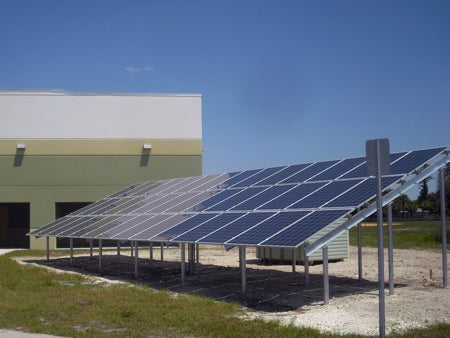Nearly 100 Florida schools will be soaking up solar rays to power their buildings this fall thanks to the Florida Solar Energy Center (FSEC).
FSEC, a University of Central Florida research institute, is providing each school with a 10-kilowatt, solar photovoltaic (PV) system valued at more than $80,000. These systems allow schools to capture the sun’s rays and turn them into energy to help reduce electricity costs, and they also serve as generators during a power outage. Installation of the systems – under way now – will reduce energy costs by up to $1,500 a year and decrease greenhouse gas emissions.
Each ground-mounted, 1000-square-foot PV system is capable of providing enough power to run a small appliance like a fridge, overhead lighting or series of electrical outlets.
Schools are getting the systems through the SunSmart Schools E-Shelter program, which was created with a $10 million stimulus grant. A leader in solar energy research, FSEC is coordinating the program and providing educational materials for teachers to use with students, as well as training for school faculty and staff.
“Having these photovoltaic systems in plain view on the school campuses is that first step in raising awareness about this important renewable energy technology,” said Susan Schleith, FSEC project manager for the SunSmart program. “And when a student, parent or teacher asks, ‘What is that and what does it do?,’ that’s when the learning begins.”
Schools receiving the systems are from around the state and include elementary, middle and high schools as well as one college. They were selected to take part in the program based on their status as an emergency shelter, demographics, and their renewable energy education and outreach plans.
Each PV system is connected to the utility electric grid, supplements the school’s electricity during normal operations and keeps a bank of back-up batteries charged. In the event the school is being used as a shelter and there’s an electrical outage, the system powers critical items in the shelter, using the back-up batteries when the sun isn’t shining.
For classroom learning, the system also functions as a learning resource, allowing students and teachers to see how much energy their system is producing, study the relationship between the environment and the PV system and explore the basics of electricity.
At the Academy of Natural Resources at Island Coast High School in Cape Coral, Fla., students take classes in subjects such as environmental science, solar energy and aquaculture. Science teacher Cherie Sukovich says the system will increase students’ understanding of how weather and other environmental factors play a role in capturing the sun’s rays.
“It gives us a very concrete, real-world way to show them an abstract concept,” she said.
Vergona-Bowersox Electric Inc., of Boca Raton, is installing the solar systems at the schools and will finish by 2012.
For more information and a list of participating schools, visit www.fsec.ucf.edu/go/sunsmart.
